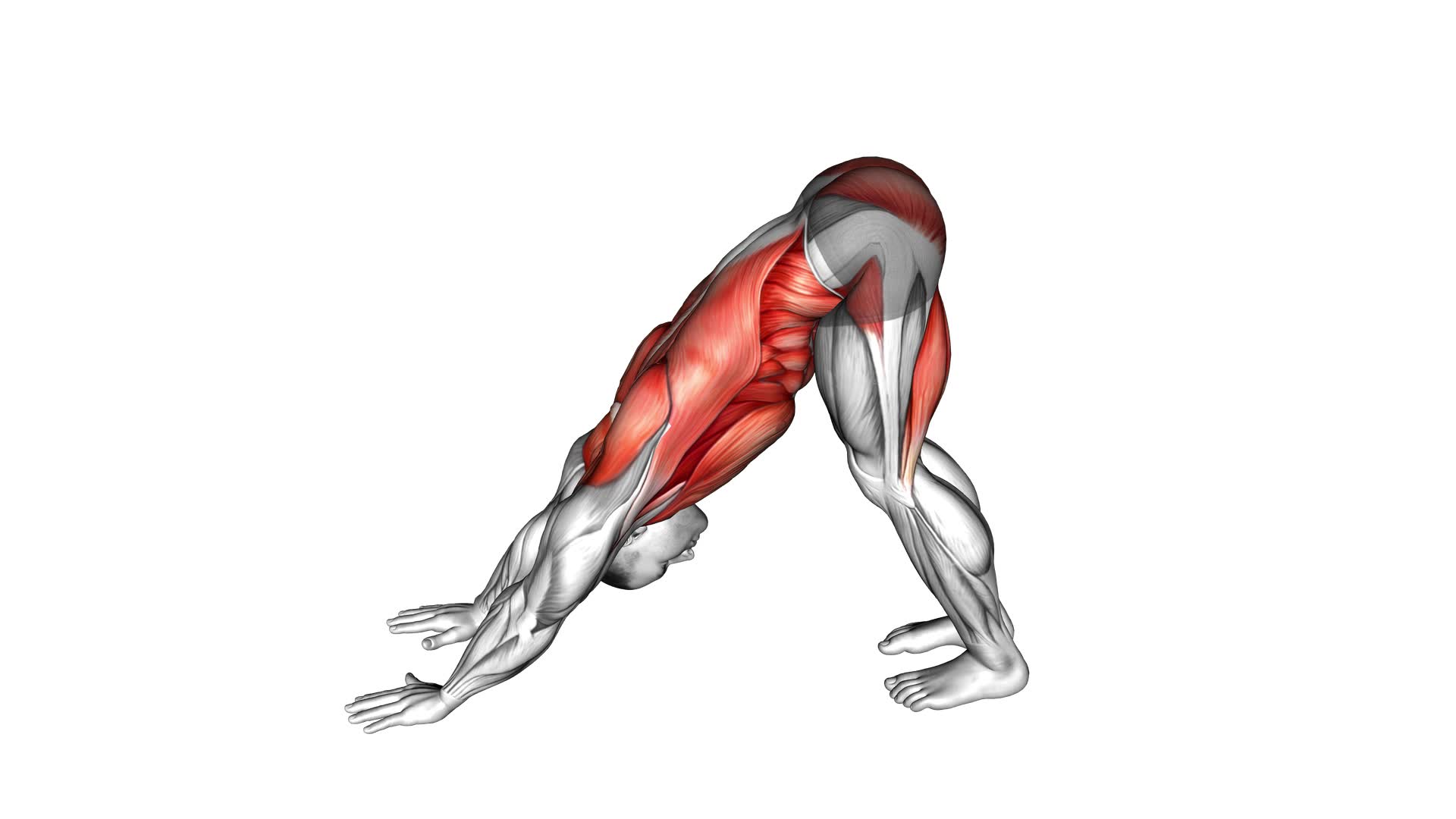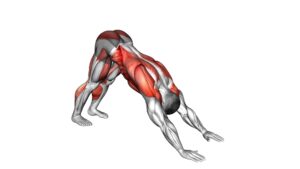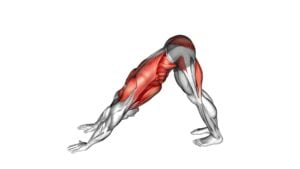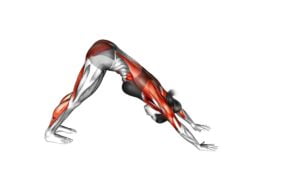Downward Dog – Video Exercise Guide & Tips

Looking to improve your downward dog? This video exercise guide and tips article is here to help!
Watch This Exercise Video
Learn how to achieve proper alignment, discover the key benefits, and explore modifications and variations that suit your practice.
Avoid common mistakes and deepen your downward dog with expert tips.
Get ready to strengthen your body, stretch your muscles, and find balance in this iconic yoga pose.
Let's dive into downward dog together!
Key Takeaways
- Proper alignment is crucial in the Downward Dog pose, ensuring a straight line from hands to hips.
- Modifications and variations are available for beginners to build strength and flexibility.
- Deepening the practice can be achieved through the use of props like blocks or straps and incorporating breathing techniques.
- Engaging the core and focusing on specific areas such as hamstrings and calves can enhance the benefits of the pose.
Proper Alignment for Downward Dog
Achieve optimal alignment in Downward Dog by positioning your body in a straight line from your hands to your hips. This foundational yoga pose may seem simple, but proper alignment is crucial for reaping its benefits and avoiding strain or injury. For beginners, there are variations of Downward Dog that can help build strength and flexibility gradually.
To improve flexibility in Downward Dog, focus on your hamstrings and calves. Start by bending your knees slightly to take some pressure off these muscles. As you become more comfortable, try straightening your legs gradually, keeping a slight bend if needed. Utilize props like blocks or a rolled-up towel under your heels to provide support and prevent strain.
Engaging your core is also essential for proper alignment. Draw your belly button towards your spine and lift your tailbone towards the sky. This will help lengthen your spine and prevent rounding in the lower back. Additionally, actively press your hands into the mat, spreading your fingers wide and grounding through your palms.
Key Benefits of Downward Dog
Experience the numerous key benefits of Downward Dog, a foundational yoga pose that improves flexibility and strengthens your entire body. Downward Dog isn't only a great way to stretch and lengthen your muscles, but it also offers a variety of other benefits that can enhance your overall well-being.
One of the major benefits of Downward Dog is that it helps to improve your flexibility. As you lift your hips towards the ceiling and press your heels towards the floor, you're actively stretching your hamstrings, calves, and shoulders. This increased flexibility can lead to improved posture, reduced muscle tension, and increased range of motion.
In addition to flexibility, Downward Dog also strengthens your entire body. It engages your arms, shoulders, core, and legs, helping to build strength and stability. This can improve your overall physical performance and make everyday tasks feel easier.
Furthermore, Downward Dog is an excellent pose for relieving stress and anxiety. The gentle inversion of the pose allows for increased blood flow to the brain, which can help to calm the mind and promote relaxation. It also helps to lengthen the spine, releasing tension and promoting a sense of grounding.
Incorporating Downward Dog into your yoga practice can provide numerous benefits, including improved flexibility, enhanced strength, and reduced stress.
Modifications and Variations for Downward Dog
To further enhance your Downward Dog practice, you can explore various modifications and variations that cater to your individual needs and level of experience. Here are three options for downward dog modifications and variations, especially for beginners:
- Half Downward Dog: If you find it difficult to fully extend your legs in the traditional downward dog pose, try the half downward dog. Start on your hands and knees, then walk your hands forward a few inches while keeping your knees bent. This modification allows you to focus on stretching your upper body and building strength in your arms and shoulders.
- Wall-supported Downward Dog: If you struggle with balance or want additional support, try practicing downward dog with the assistance of a wall. Stand facing the wall and place your hands on the wall at shoulder height. Step back, keeping your feet hip-width apart, and slowly walk your hands down the wall as you lower your chest towards the floor. This variation helps you maintain proper alignment and gradually build strength and flexibility.
- Downward Dog with Blocks: If you have tight hamstrings or difficulty reaching the floor, try using yoga blocks as support. Start in the traditional downward dog position and place a block under each hand. This modification allows you to maintain proper alignment while gradually increasing your flexibility.
Exploring these modifications and variations will help you find a downward dog variation that suits your needs and allows you to progress at your own pace.
Now, let's dive into the next section about common mistakes to avoid in downward dog.
Common Mistakes to Avoid in Downward Dog
To ensure proper form and avoid potential injuries, it's important to be aware of common mistakes that can occur while practicing Downward Dog. By understanding these mistakes and implementing proper alignment tips, you can enhance your practice and reap the full benefits of this pose.
One common mistake is rounding the shoulders. When in Downward Dog, it's crucial to keep your shoulders engaged and away from your ears. Avoid collapsing through the upper back and instead focus on maintaining a straight line from your wrists to your tailbone. This will help to elongate the spine and prevent unnecessary strain on the shoulders.
Another mistake is sinking into the wrists. To avoid this, distribute your weight evenly between your hands and fingers. Press firmly into the mat, engaging your hands and creating a strong foundation. This will help to alleviate any discomfort or pressure in the wrists.
Additionally, pay attention to your hips. It's common to let the hips lift too high or sink too low in Downward Dog. Aim to find a neutral position, where your hips are in line with your shoulders. This will help to create stability and balance in the pose.
Lastly, avoid letting your heels lift off the mat. If you find this happening, try bending your knees slightly or using a block under your hands to elevate yourself. This will allow you to maintain proper alignment and prevent strain in the calves and hamstrings.
Tips for Deepening Your Downward Dog Practice
To deepen your Downward Dog practice, focus on cultivating strength and flexibility in your body. Here are three tips to help you enhance your Downward Dog pose:
- Utilize yoga props: Incorporating props such as blocks or straps can assist you in deepening your practice. Placing a block under your hands can help you find the optimal alignment by bringing the ground closer to you. Using a strap around your shoulders or hips can help you maintain proper alignment and provide support if you have tight muscles or limited flexibility.
- Engage in breathing techniques: Deepening your breath while in Downward Dog can help you relax and find a deeper stretch. As you inhale, focus on expanding your ribcage and filling your lungs with air. On the exhale, allow yourself to surrender deeper into the pose, releasing tension and finding more space in your body.
- Gradually increase your hold time: Start by holding Downward Dog for a few breaths and gradually work your way up to longer durations. This will allow your body to adapt and build strength over time. Remember to listen to your body and take breaks when needed, as pushing yourself too hard can lead to injury.
Frequently Asked Questions
Can Downward Dog Help Improve Flexibility in Other Parts of the Body?
Downward dog is a great pose for improving flexibility in various parts of your body. By stretching your hamstrings, calves, and shoulders, it helps to increase your overall range of motion.
Additionally, downward dog modifications and variations can target specific areas, such as the hips or upper body, allowing you to focus on improving flexibility in those areas.
Incorporating these modifications and variations into your practice can help you achieve greater flexibility throughout your entire body.
Is It Necessary to Warm up Before Practicing Downward Dog?
Before practicing downward dog, it's important to warm up your body. Warming up helps to increase blood flow, improve flexibility, and reduce the risk of injury.
While downward dog is a great warm-up exercise, there are alternative warm-up exercises you can do as well. These include gentle stretches, light cardio exercises, or even a short yoga flow.
Can Downward Dog Be Modified for Individuals With Wrist or Shoulder Issues?
If you have wrist or shoulder issues, it's important to modify your Downward Dog pose. There are alternative poses that can be done instead to avoid any discomfort or further injury.
It's crucial to listen to your body and make adjustments as needed. By practicing modifications and trying out alternative poses, you can still benefit from the core strengthening and stretching that Downward Dog offers, without putting strain on your wrists or shoulders.
How Long Should One Hold the Downward Dog Pose for Maximum Benefits?
To maximize the benefits of the downward dog pose, it's important to hold it for an adequate amount of time. Holding the pose for at least 30 seconds allows your muscles to stretch and strengthen, improving flexibility and stability.
By staying in the pose, you also engage your core and upper body, increasing muscle tone and endurance.
However, keep in mind that if you have wrist or shoulder issues, modifications may be necessary to avoid discomfort or pain.
Are There Any Contraindications or Precautions to Consider When Practicing Downward Dog?
When practicing downward dog, it's important to be aware of any contraindications or precautions that may apply to you. Certain conditions, such as wrist or shoulder injuries, high blood pressure, or pregnancy, may require modifications or avoidance of this pose.
It's always recommended to consult with a qualified yoga instructor or healthcare professional before attempting downward dog if you have any concerns. Prioritizing your safety and well-being is crucial in any exercise practice.
Conclusion
In conclusion, downward dog is a versatile and beneficial yoga pose that can be modified to suit individual needs.
By focusing on proper alignment and avoiding common mistakes, you can deepen your practice and experience the full benefits of this pose.
Remember to listen to your body and make adjustments as necessary.
With practice and dedication, downward dog can become a powerful addition to your exercise routine.

Author
Years ago, the spark of my life’s passion ignited in my mind the moment I stepped into the local gym for the first time. The inaugural bead of perspiration, the initial endeavor, the very first surge of endorphins, and a sense of pride that washed over me post-workout marked the beginning of my deep-seated interest in strength sports, fitness, and sports nutrition. This very curiosity blossomed rapidly into a profound fascination, propelling me to earn a Master’s degree in Physical Education from the Academy of Physical Education in Krakow, followed by a Sports Manager diploma from the Jagiellonian University. My journey of growth led me to gain more specialized qualifications, such as being a certified personal trainer with a focus on sports dietetics, a lifeguard, and an instructor for wellness and corrective gymnastics. Theoretical knowledge paired seamlessly with practical experience, reinforcing my belief that the transformation of individuals under my guidance was also a reflection of my personal growth. This belief holds true even today. Each day, I strive to push the boundaries and explore new realms. These realms gently elevate me to greater heights. The unique combination of passion for my field and the continuous quest for growth fuels my drive to break new ground.







